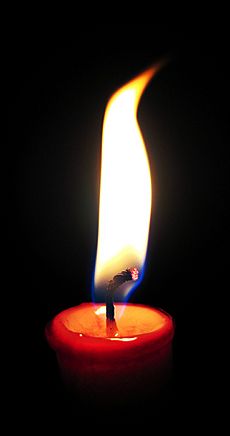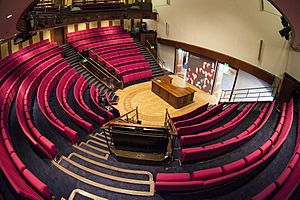Royal Institution Christmas Lectures facts for kids

The Royal Institution Christmas Lectures are a super cool series of science talks held every year in London. They happen at a place called the Royal Institution. These lectures started way back in 1825! That's almost 200 years ago! They only stopped for a few years during the Second World War. The idea is to make science fun and easy to understand for everyone, especially young people. A famous scientist named Michael Faraday started these lectures. He gave 19 different series of talks himself!
A Look Back at the Lectures
The Christmas Lectures began in 1825 and have happened every year since, except during the Second World War. They usually take place at the Royal Institution building. Sometimes, they've been held elsewhere when the building was being fixed up.
Michael Faraday was the person who started these amazing lectures. He gave them many times. Other famous scientists who have given the lectures include Nobel Prize winners Sir William Henry Bragg and his son Sir Lawrence Bragg. Many other well-known people like David Attenborough, Carl Sagan, and Richard Dawkins have also given these talks.
The special equipment and demonstrations for the lectures are made by the Royal Institution's science technician. Michael Faraday himself used to have this job! A very popular technician named Bill Coates worked there for many years, from 1948 to 1986, especially when the lectures started being shown on TV.
The people who plan the lectures decide on the main topic in the spring. The details are worked out by September, and the lectures are recorded in December. For a while, there were five lectures in each series. But in 2010, the Royal Institution had some money problems, so they reduced the series to three lectures.
Lectures on TV
The very first Christmas Lecture shown on TV was in 1936. It was given by G. I. Taylor on the BBC's new Television Service. From 1966 to 1999, the lectures were shown on BBC Two. Then, from 2000 to 2004, they moved to Channel 4. In 2000, one of the lectures was even broadcast live for the first time!
After Channel 4 stopped showing them, there was a worry that the lectures might not be on TV anymore. But Channel Five decided to show them from 2005 to 2008. In 2009, they were on More4. Finally, in 2010, the lectures returned to the BBC and have been shown on BBC Four every year since.
In 1994, Professor Susan Greenfield became the first woman scientist to give the Christmas Lectures. In 2015, Kevin Fong was the first non-white science lecturer. And in 2020, Professor Christopher Jackson became the first black scientist to present the series.
The Royal Institution is trying to find old recordings of some lectures that are missing from the BBC's archives. These include full series from 1966, 1967, 1969, 1970, and 1971, plus one episode from David Attenborough's 1973 lectures called "The language of animals."
Past Lectures: A Glimpse
Over the years, many different scientists have given lectures on a huge range of topics. Here are just a few examples from the many hundreds of lectures that have taken place:
| Year | Lecturer(s) | Title of series |
|---|---|---|
| 1825 | John Millington | Natural Philosophy |
| 1827 | Michael Faraday | Chemistry |
| 1848 | Michael Faraday | The Chemical History of a Candle |
| 1919 | William Henry Bragg | The World of Sound |
| 1934 | William Lawrence Bragg | Electricity |
| 1973 | David Attenborough | The Language of Animals |
| 1991 | Richard Dawkins | Growing Up in the Universe |
| 1994 | Susan Greenfield | Journey to the Centre of the Brain |
| 2015 | Kevin Fong | How to survive in space |
| 2021 | Jonathan Van-Tam | Going viral: How Covid changed science forever |
See also
 In Spanish: Royal Institution Christmas Lectures para niños
In Spanish: Royal Institution Christmas Lectures para niños



